What Is My Favourite Dinosaur?
Part 2: Carnivores!
A blog post by Felicity.
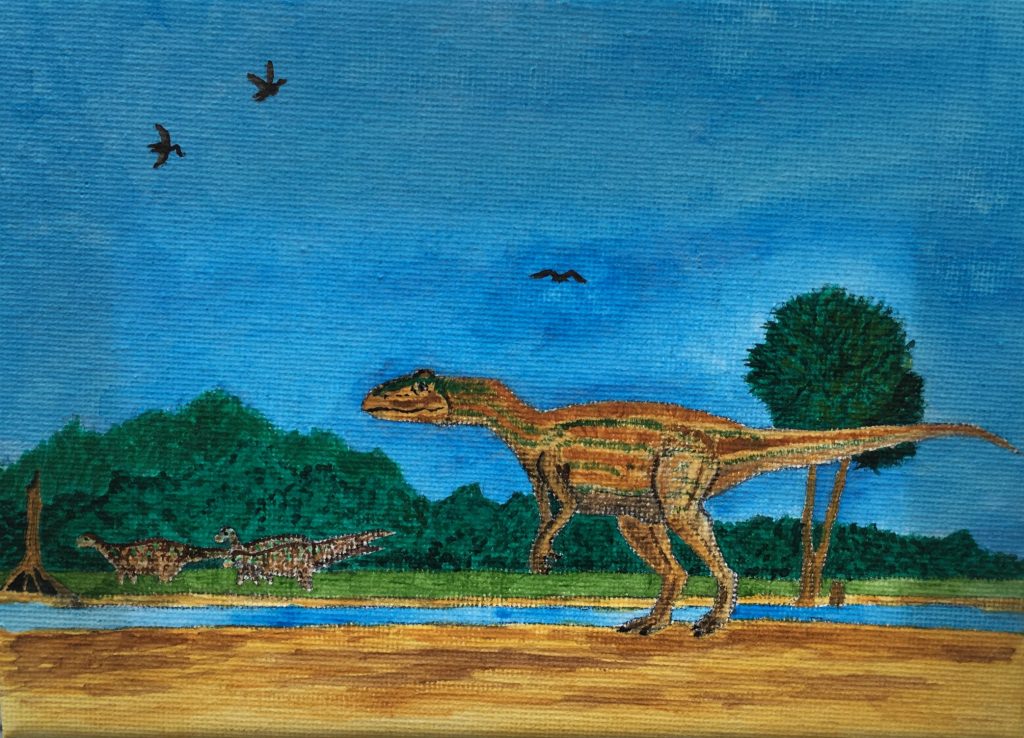
In my last post about choosing a favourite dinosaur we mainly focused on herbivore dinosaurs, the plant eating dinosaurs. This post therefore will be one for the carnivores. I mentioned in the last post that most people have heard of the Triceratops, Stegosaurus, T-Rex and one of the sauropods such as the Brachiosaurus. When you look at that list, all but one of those most famous of dinosaurs are herbivorous.
I think you also get greater variety in plant eating dinosaurs than meat eating ones when you look at their appearance. That is not to say however that you don’t get a huge amount and assortment of theropod/ carnivorous dinosaurs. They just share a lot of similar features.
The most famous of all must be the Tyrannosaurus Rex. The Jurassic Park franchise does throw in an assortment of dinosaurs, many of them being carnivores and some of them being completely fictional, while others are based in reality but then have a large amount of artistic licence on top. In my last post I explained about the Dilophosaurus and Velociraptor portrayed being largely fictional, though based in reality, but the amount of times on one of my fossil trips I ask for examples of theropod dinosaurs and someone suggests Indominus Rex is quite worrying!
Jurassic Park features their version of the Velociraptor quite heavily, yet it is still the T-Rex that has always been the main carnivore people will know. It is featured in more films and is famous largely, I think, for its size. Everyone knows the T-Rex and, to be honest, I think Jurassic Park did quite a good job with this dinosaur. Don’t get me wrong, they got some things wrong here too – if you ever found yourself confronted by a living T-Rex and you thought staying still would keep you hidden, you would be a quick and easy snack as T-rex had better vision than yours or mine! If I remember correctly, in Michael Crichton’s book this handicap for T-rex was actually attributed to the amphibian DNA the scientists used to create their hybrid dinosaurs during the cloning process but this was left out of the films and just taken as a T-Rex fact. Poor Alan Grant got it so wrong and while my Mum thinks the actor Sam Neill is tasty, the film writers decided T-Rex didn’t get the chance to find out!
Where they did get T-Rex spot on was, I believe, in its movement. It was down to using CGI (new technology back then!) that they were able to work out what sort of speed a T-Rex could have realistically moved and how the muscles would have attached to the bones and how all of this worked together to create a practical, realistic movement. Before this technology I believe scientists thought T-Rex would have moved faster than they later found was possible. Wonderful to think that making a fictional movie actually helped the scientific community in this way.
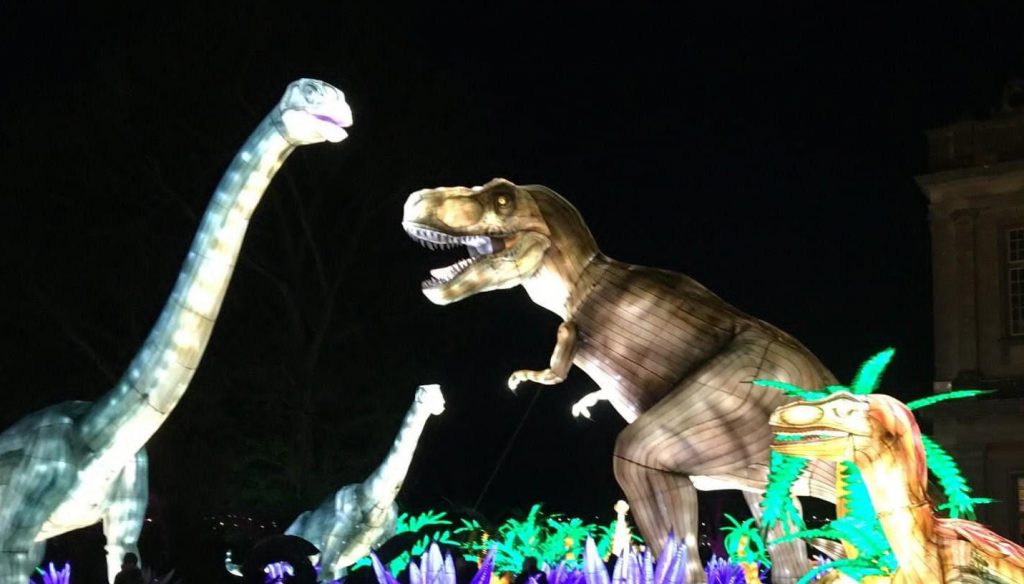
Anyway, I digress. In a moment we will look at carnivores but first a quick note (that I probably should have mentioned in my last post, but better late than never) about time periods.
The age of dinosaurs is split into three time periods. Triassic, Jurassic and the Cretaceous. In the Triassic, dinosaurs were just getting started and the majority were somewhat smaller than most people imagine a dinosaur to be. In the Jurassic they were getting bigger and you had more variety of species but it was really in the Cretaceous that we had the truly gigantic species we all know and marvel at. Dinosaurs actually existed for a greater time span than that which separates us from them. That is a lot of time to fit in an extraordinary variety of dinosaur species.
Going back to the Late Triassic and Early Jurassic we have the Coelophysoidae. This group contains the small, early theropods. Slender dinosaurs ranging in size from about three to twenty feet in length. The one I particularly like is the Coelophysis. A small bipedal carnivore which grew to about 9.8 feet long. The reason I like this dinosaur is because of a fun fact I learned about ten years ago which is that we have sent dinosaurs into space and Coelophysis is one of them. A Coelophysis skull from the Carnegie Museum of Natural History was sent into space in 1998 aboard the Space Shuttle Endeavor. It was taken onto the space station Mir before being returned to Earth. We have had Coelophysis on record for over 100 years and it is so popular that it was designated the official state fossil of New Mexico in 1981!
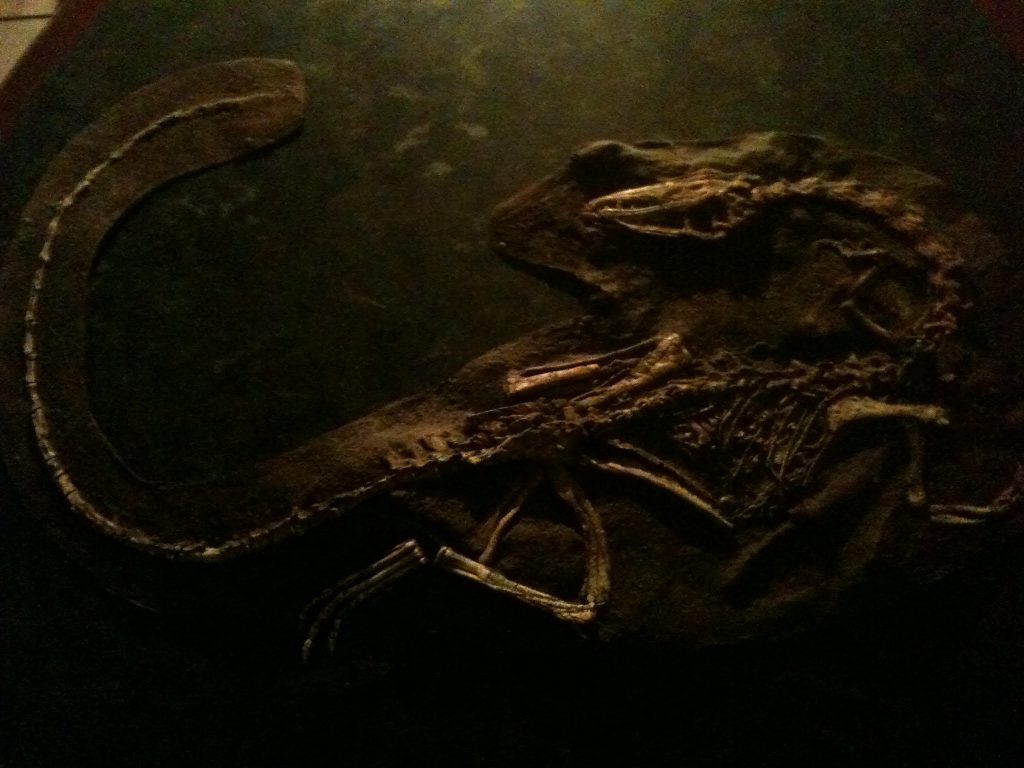
If that wasn’t enough to make this dinosaur one of your favourites there are others in this group such as the Procompsognathus, a cutie bipedal carnivore (from the Late Triassic) measuring up to 3.3 feet in length and weighing in at about 2.2 pounds. Jurassic Park Lost World shows the dinosaur Compsognathus (from the late Jurassic) while the book actually names Procompsognathus. Both species exist and, while they are not actually related, the film depiction could easily have been either dinosaur. This species is a hit with my Mum who likes the ‘cute little chirpy dinosaur’. She doesn’t seem put off by their ‘bad eating habits’.
There was an extinction event between the Triassic and Jurassic period which wiped out about 76 percent of all marine and terrestrial species. Amazingly it barely touched dinosaurs, pterosaurs, mammals and the plant life. When I first heard that fact it made me wonder and marvel at how much life there was during the Triassic that didn’t come under those groups, but sadly much of it perished. The loss of those species, however, paved the way for the dinosaurs to become the dominant species during the Jurassic period.
In my last blog post and earlier in this one I mention the Dilophosaurus. The ‘two-crested lizard’ from the Early Jurassic who featured in Jurassic Park, but in a pretty much entirely fictional manner. This dinosaur is actually in a group called the Dilophosauridae which is a stepping stone between the Coelophyoids and later theropods. There are a few dinosaurs found dating back to the Early Jurassic period but I think Dilophosaurus is one of the few that some people today have heard of.
When we look at the middle of the Jurassic Period we have the hugely important (yet not as famous as I feel it deserves to be) species Megalosaurus. This ‘Great Lizard’ was found in Oxfordshire, England, and in 1824 it was the first genus of non-avian dinosaur to be validly named. Megalosaurus (along with Iguanodon and Hylaeosaurus) led to Richard Owen creating the classification of ‘Dinosauria’.
A model of Megalosaurus was created and included in the Crystal Palace Dinosaur display which greatly increased public interest in dinosaurs. Those models are still visited by the public today and while they are inaccurate and pretty much unrecognisable by today’s standards, they still played a huge part in what we know of dinosaurs today. Megalosaurus was more likely a 20 foot long, 1,500 lb bipedal carnivore. A robust, heavily muscled, large headed dinosaur equipped with long, curved teeth.
It isn’t until we reach the Late Jurassic period that we start to get a couple of the carnivore dinosaurs I have come to expect (or maybe hope) people will know.
One example is the Allosaurus. One of the first well-known theropod dinosaurs outside paleontological circles. Allosaurus was about 29 feet long with the powerful hindlimbs and comparatively delicate forelimbs, a long muscular tail and a light but robust skull filled with dozens of sharp, serrated teeth. Allosaurus is one of the dinosaurs, for people that still don’t know the species, I describe as being similar to Jurassic Park’s Velociraptor but with a hint of T-Rex thrown in.
This dinosaur was certainly at the top of the food chain during the Late Jurassic period capable of feeding on large herbivores and likely even other predators. While some palaeontologists believe group cooperation was likely for this species (again, think Jurassic Park Velociraptors working together to hunt in packs) others reckon individuals may have been aggressive towards each other. (I am in favour of both being accurate – in many animals we see today you have groups of females living together, while males hunt alone or in smaller groups and variations depending on other factors than gender such as age and food supply.)
Another fairly well-known example from the Late Jurassic is the Ceratosaurus. This 17-23 foot long theropod is classed as ‘medium sized’ by many and with very short yet fully functional forelimbs and weighing in somewhere between 922 – 1,480 lb. The body plan, like Allosaurus, is typical of the larger theropod dinosaurs. Ceratosaurus had a large head with deep jaws that supported proportionally very long, blade like teeth. What makes this dinosaur stand out for me though is the prominent ridge like horn on the midline of the snout, a pair of horns over the eyes and a row of small skin bones running down the middle of the dinosaur’s neck, back and tail. More of these skin bones (osteoderms) were present at currently unknown positions on the animal’s body. This dinosaur not only had impressive teeth, he was spikey too. His face could certainly make a statement!
Moving now to the Early Cretaceous and people (particularly the youngster ‘dinosaur enthusiasts’ on my tours) start to recognise even more carnivore names. A notable one for me would be the Deinonychus. This is one of the dinosaurs that Jurassic Park’s Velociraptor was based on, but what makes it noteworthy for me is because it is due to the study of this species in the 1960s which led to the ‘dinosaur renaissance’ and started the debate questioning if dinosaurs were warm-blooded or cold-blooded. For appearance I tell people to imagine the Velociraptor, make him about 11 foot long, 160-220 lbs and likely covered in feathers. The name means ‘Terrible Claw’ too, so don’t forget those large sickle-shaped talons on the second toe of each hind foot.
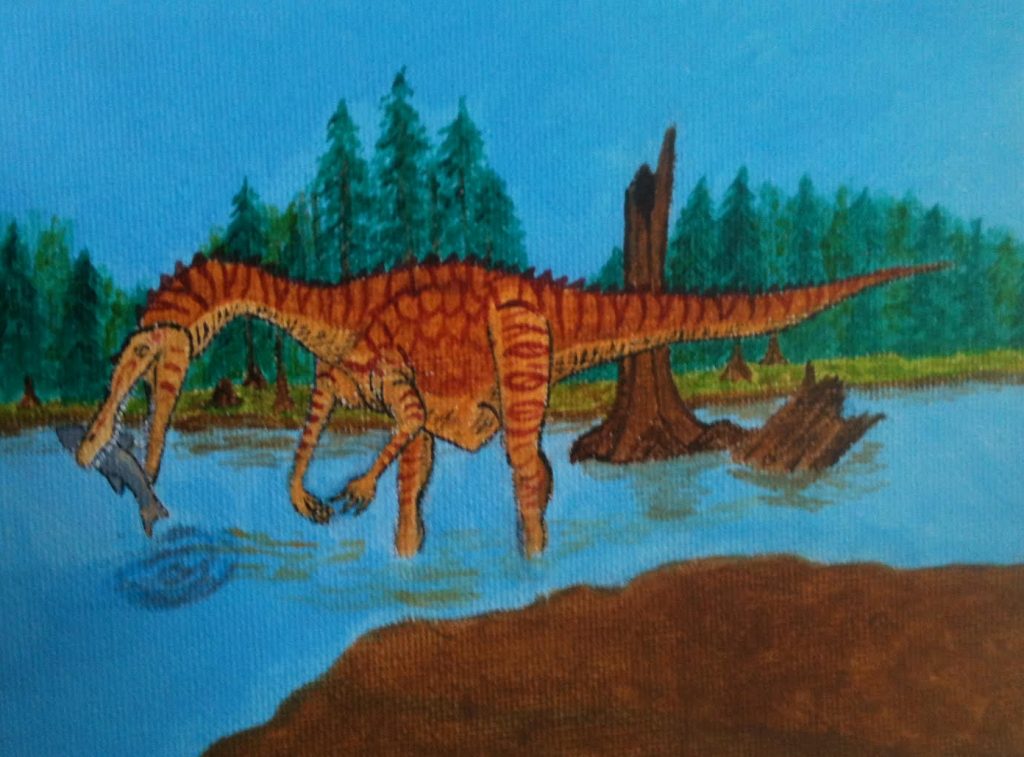
Another species I particularly like from the Early Cretaceous is the Baryonyx. The first fossil skeleton from this species was found in 1983 in Surrey, England but this species remains are also found on the Isle of Wight. Sadly, most people today have heard of Spinosaurus (also featured in the Jurassic Park franchise) but not always Baryonyx. Spinosaurus didn’t come along till the Late Cretaceous so a while after the Baryonyx, but both are types of Spinosaurid.
The Baryonyx holotype specimen is one of the most complete theropod skeletons from the UK and the most complete example of a Spinosaurid. For this species I tell people to imagine a standard carnivore body shape and make it 30 foot long with a crocodile face and ‘heavy claws’, which this dinosaur used to hook fish from rivers and streams and add a frill or fin along the length of its back. Bayonyx was the first theropod found to eat fish – evidenced by the remains of fish scales in the stomach region of the holotype specimen. There is also the possibility that Baryonyx hunted other dinosaurs or at least scavenged the remains as bones of a juvenile Iguanodon were also present in the stomach region.
I think the Baryonyx is a fascinating species as it may have also lived a semiaquatic lifestyle coexisting with crocodiles, turtles, fish, pterosaurs and with other dinosaurs. In recent years two new Spinosaurid dinosaurs have also been discovered on the Isle of Wight. One is named ‘Ceratosuchops Inferodios’ meaning ‘Horned Crocodile-Faced Hell Heron’ – quite the name! Imagine Baryonyx but with low horns and bumps ornamenting the brow region.
The next species is the ‘Riparovenator Milnerae’ which means ‘Milner’s Riverbank Hunter’ in honour of Angela Milner, esteemed British Palaeontologist who recently passed away and who studied and named the Baryonyx. The study of these two new species alongside Baryonyx suggests the Spinosaurid species may have first evolved in Europe before dispersing into Asia, Africa and South America.
At some point I will likely write a blog post about the other species found on the Isle of Wight as not only do we have the dinosaurs paving the way for Spinosaurus but we also have the ancestors of the T-Rex and the genuine Velociraptor found here, but only people interested or involved in palaeontology seem to really know about them, so they are less likely to be your favourite, and so don’t really belong in this post!
One last fabulous example of an Early Cretaceous Spinosaurid dinosaur would be the ‘Irritator’.
That’s right, a dinosaur has been named ‘Irratator’! Considering all the long, crazy, amazing and creative names out there for dinosaurs – I really like that someone decided to go with this. The reason is a bit of a shame – it involved fossil poachers illegally hunting where they shouldn’t have been and fossil collectors who didn’t really know what they were doing messing with the skull (filling parts of it with car body filler for example) to make it look more complete and therefore valuable but making a right mess of it! The skull was mistaken for a pterosaur for a while before actual experts got their hands on it and then had a long and difficult process of undoing the damage and figuring out what it was they actually had. The name comes from this and the irritation they felt at discovering that the snout had been artificially elongated. I think they were being polite by leaving it at Irritator!
Another famous and certainly impressive carnivore from the early Cretaceous is the Carcharodontosaurus. These were some of the longest and heaviest carnivorous dinosaurs we are aware of today. Their estimated size ranges from 39-45 feet in length and weighing in between 6.2- 15.1 tons. They had enormous jaws with long, serrated teeth up to eight inches long. Their skulls alone were 4-5 feet long. While not as famous as the T-Rex, this dinosaur could certainly rival and maybe even best it in terms of size! The largest theropod skull currently on record is 6.4 feet long and belongs to another species in the Carcharodontosaurid group, the Giganotosaurus but that species comes along later in the Late Cretaceous.
Another famous carnivore from this time period is the Utahraptor. This dinosaur was found the year that Jurassic Park came out and gave scientific credence to the large raptors in the movies. Really it should have been the Utahraptors rather than the Velociraptors that featured and shot to fame as a result. These dinosaurs were 23 feet long making them twice the size of the aforementioned Deinonychus (the other main inspiration for the fictitious version of the Velociraptor) and sporting the large, curved claws on their second toes. These dinosaurs were powerful, relatively thickly built – with some believed to have weighed in at approximately 1,100 lb they were comparable in weight to a polar bear!
Going in the other direction from the large Utahraptor, but along related lines, would be the Microraptor. This dinosaur is in the same ‘Dromaesaurid’ group as the Utahraptor and also found in the Early Cretaceous but instead of in Utah this one is found in China. At 2-3.9 feet long and an estimated weight of only 2.2 lbs you wouldn’t necessarily put these two dinosaurs in the same group. The thing they did have in common was a covering of feathers. It is now believed that many species of carnivorous dinosaur had feathers. What makes this species interesting and beautiful to me is that this one is a genus of small, four winged dinosaurs. While people usually know the Archaeopteryx for its importance as the ‘first bird’, well preserved fossils from Microraptor also give key evidence in helping us to understand the evolutionary relationship between dinosaurs and modern-day birds. While many scientists speculated that it used its four limbs to glide, recent research suggested they were capable of powered flight as well. While it is virtually impossible to picture the Utahraptor flying it is very easy to imagine the Microraptor taking to the air.
The mid-late cretaceous has a wonderful range of dinosaurs and thankfully at least some of them are relatively well known.
One species I feel a bit sorry for is the Oviraptor. Estimated at only 5.2 feet long and likely weighing in at 73-88 lb this dinosaur was rather small and feathered. Oviraptor was actually toothless and instead had a horny beak most similar to that of a parrot or turtle. This fact, along with the fact that the holotype for the species was found with a nest thought to belong to Protoceratops, led people to believe that the species was ovivarous meaning it had an egg-based diet. A later theory emerged that the jaws were actually strong enough to break mollusc and clam shells.
It was later argued that the jaws were more likely used for shearing surfaces suggesting leaves entered into this dinosaur’s diet. When the fragmented remains of a lizard were found in the holotype specimens body cavity it was then thought that Oviraptor was at least partially carnivorous, most likely this dinosaur was an omnivore but favouring a diet that incorporated nuts and seeds.
Regardless of what this dinosaur actually ate, the reason I feel sorry for it is the mistaken identity or intention of this dinosaur. Oviraptor means ‘Egg Thief’ and it was originally thought that this dinosaur would steal and consume the eggs of other dinosaurs, when in fact we now know that this dinosaur was actually either tending its own nest or laying its own eggs rather than stealing the eggs of others. Imagine an Ostrich doing the same. . . now make it a dinosaur who actually looked pretty similar. That was the Oviraptor. To forever have a name that made you out to be the ‘bad guy’ when you were just nesting seems so unfair. Is that reason enough to have this as a favourite dinosaur though?
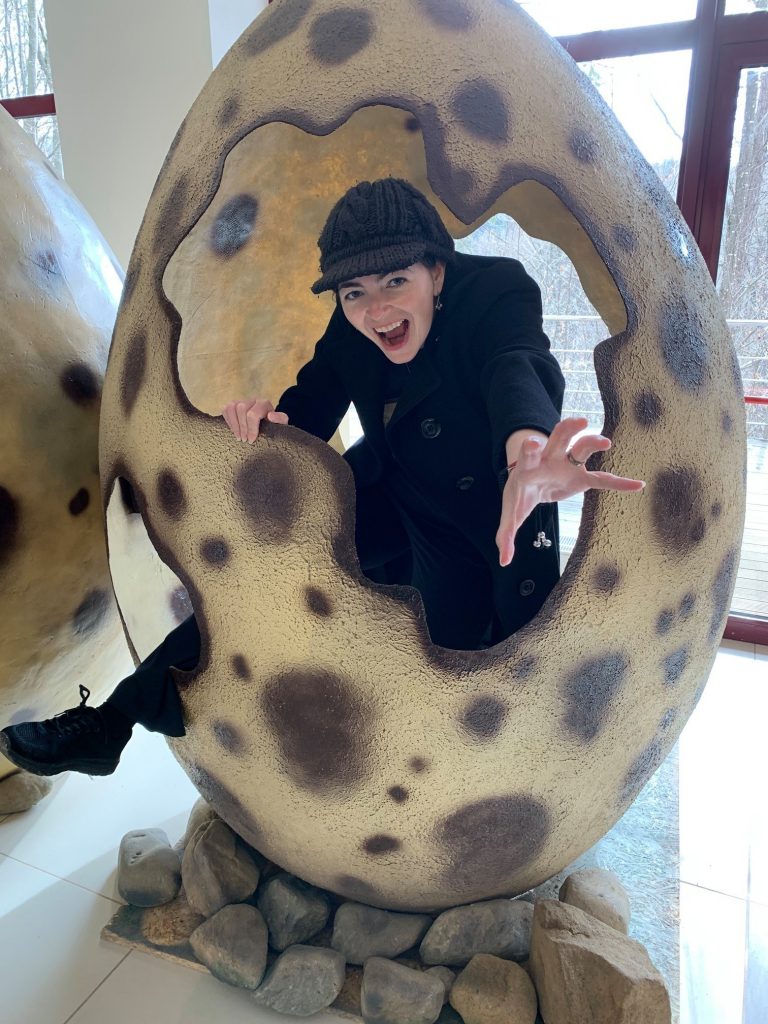
Speaking of Ostriches, another dinosaur from the late cretaceous who greatly resembled an Ostrich is the Gallimimus, which also starred in the Jurassic Park film. Though it was only on screen for one scene it was of good scientific importance. In the film you see the T-Rex hunting a herd of Gallimimus and the protagonist compares the Gallimimus to a flock of birds in the way they move and change direction. This feels important to me as dinosaurs were once heavily compared to lizards and crocodiles where the better comparison lies with modern day birds. This scene helped to shift that perception in the public’s minds. Gallimimus was about 20 foot long and weighed 970 lb. A beaked dinosaur sporting feathers. The name means ‘Chicken Mimic’ due to similarities between the vertebrae in the neck but I think overall ostrich mimic would fit better.
While we are talking bird- like dinosaurs perhaps it is, at last, time to look at the Velociraptor. The real one rather than the Steven Spielberg one. The name means ‘Swift Seizer’ and while it was related to the Deinonychus in that it was also a Dromoaeosaur, the Velociraptor was smaller. Like the Deinonychus, the Velociraptor was bipedal, covered in feathers and had the classic enlarged sickle- shaped claw on the hindfeet. Velociraptor had a different skull shape though. Long and low with an upturned snout. This dinosaur was turkey sized and weighing about 33lb but don’t let their size fool you – one of the most famous fossils we have of this species is one preserved mid-combat with a Protoceratops. The Velociraptor may have been much smaller than the ones portrayed on the big screen but they were still deadly.
Over the years we have discovered that a lot of carnivores had feathers. This is not true for all of them though as evidenced by the Carnotaurus. Though the species was known from a single well preserved skeleton it is one of the best understood theropods from the southern hemisphere and has some interesting and quite unique features. This dinosaur was about 25 feet long and estimated to weigh at least 1.35 tons. This dinosaur was lightly built, it had small vestigial forelimbs and long slender hind limbs. It was well adapted for running and was likely one of the fastest large theropods. The head was short snouted but a very deep skull sat atop the muscular neck. What makes this species distinctive is the thick horns above the eyes – a feature unseen in other carnivores. This skeleton was so well preserved it had extensive skin impressions, showing a mosaic of small, non-overlapping scales interrupted by large bumps along the sides of the dinosaur. It is theorised that the horns on the brow and the strength of the neck aided in combat with rivals as the species would have been able to exchange head blows and ram each other head-on. This dinosaur’s brain suggests that its sense of smell was better developed compared to hearing and sight.
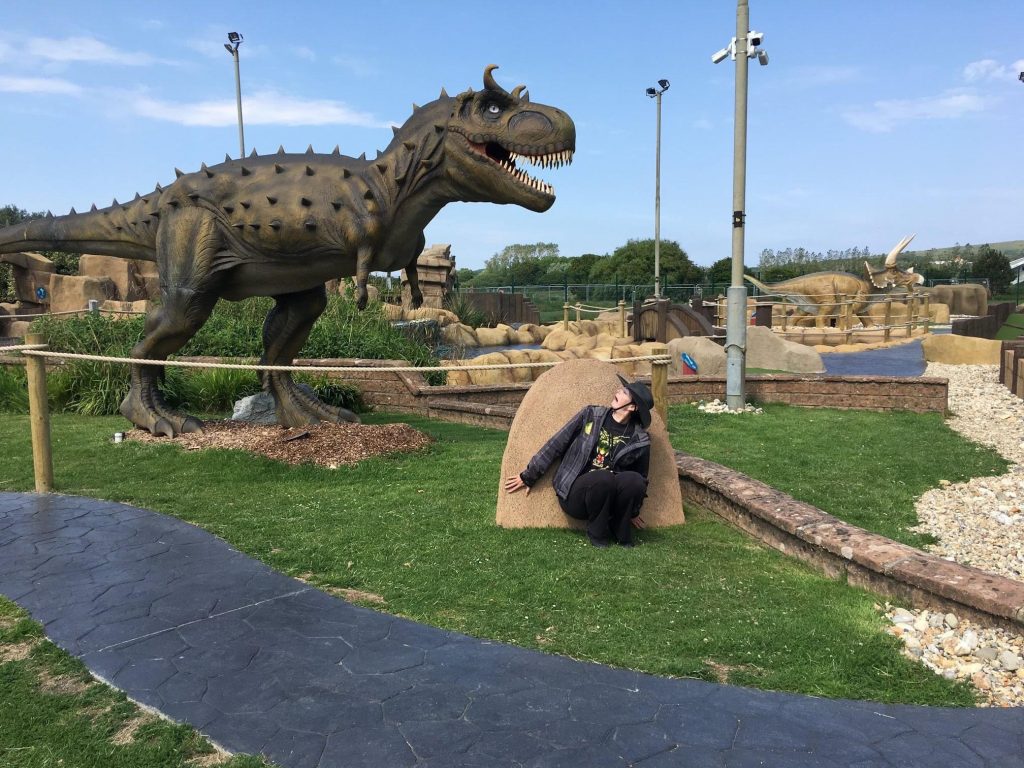
As we move towards the latter part of the Cretaceous and the end of the time of dinosaurs, we have some of the notable ones we already mentioned in passing such as the Spinosaurus and the Giganotosaurus. While T-Rex has always been considered the largest theropod dinosaur of all time, it now has company at the top. Many now believe Spinosaurus to be the largest terrestrial carnivore dinosaur but the others of a similarly gigantic size are the Giganotosaurus, the Carcharodontosaurus and of course good old Tyrannosaurus. Spinosaurus estimates put this species at 49-52 feet and weighing in at 6.4-7.5 tons. That was one big crocodile faced dinosaur! Giganotosaurus the ‘Giant Southern Lizard’ meanwhile looks more like a T-Rex with a slightly more raptor shaped face and estimates put this giant at 39-43 feet long and weighing in at 4.2 – 13.8 tons. Carcharadontosaurus meanwhile we already know is estimated to have been 39 – 45 feet long and weighing in at 6.2 – 15.1 tons.
I guess that brings us to conclude with the Tyrannosaurus, the King of Dinosaurs! The T-Rex was the last known member of the Tyrannosaurids and among the last non-avian dinosaurs to exist before the extinction event that wiped out dinosaur kind. There are other well known dinosaurs in the Tyrannosaurid group such as the Albertosaurus (interesting species for the fact that 26 individuals were discovered at one site providing evidence of pack behaviour) and the Tarbosaurus (known for the unique locking mechanism in its lower jaw and the smallest forelimbs relative to body size of any Tyrannosaurid) but none so famous as the T-Rex. The Tyrannosaurids were bipedal carnivores with gigantic skulls balanced by a long, heavy tail. The forearms always look short and silly compared to the rest of the animal, but they were unusually powerful in the T-Rex. It is estimated that T-Rex could exceed 40.7 feet long and weigh in at 8.4- 14 tons. While a select few theropods may have rivalled or exceeded T-Rex’s size, the species still had the strongest bite force among all terrestrial animals as well as the largest teeth of any carnivorous dinosaur yet found. The King was likely an apex predator and the largest in its environment. This dinosaur would have been able to prey upon Hadrosaurs, young Ceratopsians and Ankylosaurs and probably even Sauropod long neck dinosaurs, but did it?

A massive beast, yet one of the longest debates in palaeontology was questioning if the T-Rex was an apex predator or purely a scavenger. Today it is largely accepted that both are true. This species has some almost complete skeleton specimens and one example even yielded soft tissues and proteins. So much fossil material from this species has been found that extensive research into the dinosaur has been conducted. We are not about to create a real version of Jurassic Park any time soon, but some amazing studies have been conducted to better understand the world these dinosaurs inhabited and what part they played in that world.
With so many amazing carnivores listed and so many more I haven’t mentioned, how can I pick a favourite!? Can you? If you have a favourite carnivore dinosaur, please let me know in the comments below.
In my next post I will take a look at the Iguanodon.
Thank you for reading,
Felicity
P.S.
Find out about our new documentary (Seeking The First Dinosaur Hunters), and where to watch it, at www.seekingthefirstdinosaurhunters.com.
P.P.S.
If you enjoyed this blog post, please leave a comment and say ‘hello’!
For information on all of our projects, visit: www.gregandfelicityadventures.com
Follow us on Instagram at: https://www.instagram.com/gregandfelicity
Like us on Facebook at: https://www.facebook.com/GregandFelicityAdventures
There are various places you can watch our documentaries and series!
Seeking Cetaceans In Scotland: A two-part documentary about the work of the Cetacean Research and Rescue Unit as they work to help whales, dolphins and porpoises in the Moray Firth in Scotland:
Free in the USA on Tubi TV at:
https://tubitv.com/movies/678018/seeking-cetaceans-in-scotland
Free Worldwide on PlexTV at:
https://watch.plex.tv/movie/seeking-cetaceans-in-scotland
With a library card on the Hoopla service where applicable:
https://www.hoopladigital.com/title/15313766
Free in the USA on Xumo at:
https://www.xumo.tv/channel/99991731/free-documentaries?v=XM00ILOFXCKLUC&p=74071
Buy it without ads Amazon’s Prime Video at:
UK: https://www.amazon.co.uk/dp/B09RVWVFCV
USA: https://www.amazon.com/dp/B09RVWJGY1
(Greg and Felicity are donating half of our streaming income on this documentary to support the CRRU).
Available to buy on DVD (with £5 from each donated to the charity): https://ko-fi.com/s/73e469d114
ROMANIA: SEEKING DRACULA’S CASTLE: Our travel documentary looking into the history, legend and castles connected to Vlad Dracula III, sometimes known as Vlad the Impaler, and a journey around Romania:
Free Worldwide on Plex: https://watch.plex.tv/movie/romania-seeking-draculas-castle
Free (USA) on Tubi: https://tubitv.com/movies/579192/romania-seeking-dracula-s-castle
Prime Video (From £1.99, no Ads) (UK): https://www.amazon.co.uk//dp/B08RDPZP14
Prime Video (From $1.99, no Ads) (USA): https://www.amazon.com/dp/B08RDJR4F2
TURKEY: FAIRY CHIMNEYS AND UNDERGROUND CITIES: A travel documentary across Turkey, from the Fairy Chimneys and Underground Cities of Cappadocia to the ancient Greek ruins of Ephesus and Hierapolis:
Prime Video UK (From £2.49, no Ads): https://www.amazon.co.uk/Turkey-Fairy-Chimneys-Underground-Cities/dp/B09KKSZLRW
Prime Video USA (From $1.99, no Ads): https://www.amazon.com/Turkey-Fairy-Chimneys-Underground-Cities/dp/B09KK6VDJB
Free Worldwide on Plex: https://watch.plex.tv/movie/turkey-fairy-chimneys-and-underground-cities
Free (USA) on Tubi: https://tubitv.com/movies/579225/turkey-fairy-chimneys-and-underground-cities
Greg Chapman’s Magic Show: An eight-part series of magic and entertainment with Greg:
Free in the USA on Tubi at: https://tubitv.com/series/300008713/greg-chapman-s-magic-show
Free worldwide on Plex: https://watch.plex.tv/show/greg-chapmans-magic-show/season/1
Available to buy on DVD: https://ko-fi.com/s/7c1bc10a08
Mexico: Mayan Mystery and Marine Majesty: Filmed on our honeymoon in Mexico in 2019, our first travel documentary took us through the ancient sites of Teotihuacan, Uxmal, El Tajin, Palenque, Chichen Itza and Calakmul, and then on to see the whales of Magdalena Bay, whale sharks of La Paz, and more.
Watch free on YouTube: https://youtu.be/yfMpD868MHU
The Isle of Man: Railways, Castles and Seals: Our second travel documentary took us to the Isle of Man!
Watch free on YouTube: https://youtu.be/uCpUa6XEkbg